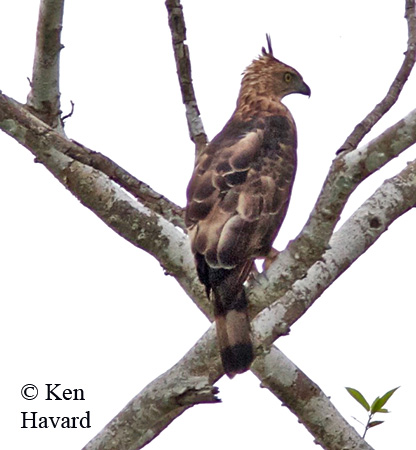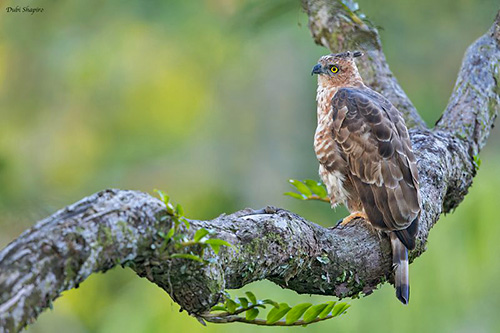
Fr: Aigle de Wallace
Ang: Wallace's Hawk-Eagle
All: Dschungelhaubenadler
Esp: Águila de Wallace
Ita: Aquilastore di Wallace
Nd: Kleine Kuifarend
Sd: Wallaces hökörn
Photographers:
Jean-Claude Billonneau
Photographe-témoin de la Beauté du Monde
Ken Havard
My Bird Gallery & Flickr gallery 1 & Flickr gallery 2
Dubi Shapiro
Dubi Shapiro Photo Galleries
Text by Nicole Bouglouan
Sources:
HANDBOOK OF THE BIRDS OF THE WORLD Vol 2 by Josep del Hoyo-Andrew Elliot-Jordi Sargatal - Lynx Edicions - ISBN: 8487334156
RAPTORS OF THE WORLD by James Ferguson-Lees et David Christie - Helm Identification Guides – ISBN: 0713680261
Birds of Borneo by G. W. H. Davison – Editeur: Bloomsbury Publishing, 2016 – ISBN: 1472932862, 9781472932860 – 144 pages
Field Guide to the Birds of Borneo by Susan Meyer – Editor: Bloomsbury Publishing, 2019 – ISBN: 1472979028, 9781472979025 – 336 pages
A Field Guide to the Birds of South-East Asia by Craig Robson. New Holland Publishers. ISBN: 9781780090498
Wikipedia, the free encyclopaedia
Wallace’s Hawk-Eagle
Nisaetus nanus
Accipitriformes Order – Accipitridae Family
INTRODUCTION:
The Wallace's Hawk-Eagle was formerly placed in the genus Spizaetus, but it is now in the genus Nisaetus which includes the species found in S and SW Asia.
The Wallace's Hawk-Eagle has two subspecies. The nominate race is found in S Myanmar, Thailand to Malay Peninsula, Sumatra and Borneo. The subspecies N.n. stresemanni from Nias Island off W Sumatra is possibly extinct.
The nominate race is among the smallest eagles. It frequents both subtropical and tropical moist lowland forests, usually around 500 metres of elevation. It feeds on various vertebrates such as birds, bats, rodents and also reptiles. The prey are usually caught within the forest or at the edge.
The breeding behaviour of this species is poorly known. The stick nest is built in tree fork, often fairly high above the ground.
The name of this beautiful raptor pays tribute to Alfred Russel Wallace, a British naturalist, explorer, geographer, anthropologist and biologist.
The Wallace's Hawk-Eagle is heavily threatened by loss, degradation and fragmentation of the lowland rainforest, including in protected areas, caused by commercial logging.
Some populations may adapt to these modifications, whereas others are absent from the disturbed forests.
The Wallace's Hawk-Eagle is currently listed as Vulnerable.

DESCRIPTION OF THE BIRD:
Biometrics:
Length: 43-58 cm
Wingspan: 95-105 cm
Weight: 500-610 g
The Wallace's Hawk-Eagle adult has black-brown upperparts. The tail is greyish with three blackish bands, the terminal one being slightly broader.
On the underparts, the throat is white with black malar stripe. The upper breast is streaked black, whereas the lower breast is barred black. The belly is buff/cream-coloured with black-brown barring on belly, flanks, undertail-coverts and tarsi.
In flight, the underwing shows buffish-white bases to flight-feathers, and warm buffish coverts with narrow, dark barring. The tail pattern is duller, with narrower and paler bands.
On the head, a tall, black, buff-tipped crest is often cocked upwards. The crown is deep black, whereas the face is tawny-rufous with black streaks, and this pattern extends to the hindneck. We can also see a black gular stripe.
The hooked bill and the cere are slate-black, with pale bases to mandibles.
The eyes are yellow.
The tarsi are fully-feathered, barred black-and-white. Feet and toes are yellow with black talons.
Male and female have similar plumage, but the female is slightly larger, in average 2%.
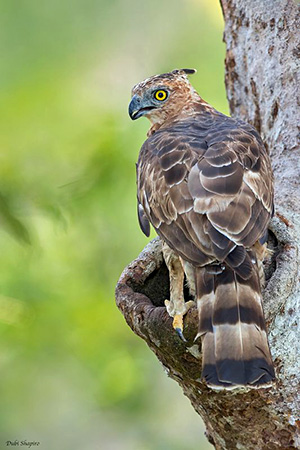
The juvenile has pale sandy-rufous to buffy or even all-white head and underparts. The breast is cinnamon-buff, sometimes well demarcated.
The upperparts show brownish-white fringed feathers.
On the head, there is sometimes a variable, narrow, black mask on the rear eye. The crest is white-tipped.
The eyes are brown.

The subadult has brown upperparts with paler neck and crown.
The underparts are whitish to pale cinnamon, with some dark streaks on central breast. A rufous barring extends from lower throat to undertail-coverts and legs. The tail pattern progresses during the third year.
SUBSPECIES AND RANGE:
The Wallace's Hawk-Eagle has two subspecies.
N.n. nanus (described above) is found in S Myanmar and Thailand to Malay Peninsula, Sumatra and Borneo.
N.n. stresemanni occurs on Nias Island, off the W coast of Sumatra.
This race is apparently not described, but probably very similar to nominate. However, the juvenile has white head, underparts and wings. On the upperparts, the feathers, including the black crest, show broader pale tips and fringes.
This race is possibly extinct.
HABITAT:
The Wallace's Hawk-Eagle frequents areas with high tree-canopy. It can be found in lowland evergreen and semi-evergreen forests including Dipterocarpaceae trees, riverine and swamp forests.
But it may also occur sometimes in secondary forest and Albizia. The species is able to adapt regionally to degraded forests and it is observed in plantations.
It is mainly found below 500 metres of elevation, but up to 1,000 metres in Borneo.
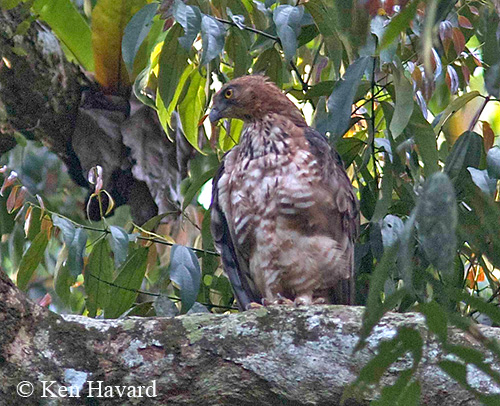
CALLS AND SONGS: SOUNDS BY XENO-CANTO
The call of the Wallace's Hawk-Eagle is a high-pitched “yik yee” or “kliit-kleeik” during which the second note is rising.
The hawk-eagles of both Spizaetus and Nisateus genera tend to have clear courtship display calls, usually louder and more musical than those of the eagles of genus Aquila.
After fledging, the juvenile produces high-pitched, breathless “yii-yii-yii-yii” and we can also hear some “ee ee ee ee eeee”.

BEHAVIOUR IN THE WILD:
The Wallace's Hawk-Eagle feeds on various prey including birds, bats, rodents, frogs, skinks and lizards. It usually hunts from a perch where it sits quietly, waiting for a passing prey.
This behaviour is not well known, but it probably hunts within or at the edge of the forest. It apparently hunts alone.
From an observation, a juvenile was climbing through the lower canopy while pursuing a prey, reptile or small vertebrate.
The Wallace's Hawk-Eagle performs aerial displays by soaring over the territory and often close to the nest-site while calling. The stick nest is built in tree canopy, in a branch in emergent tree.
The monogamous pair remains in the territory all year round.
The adults seem to be sedentary, but the juveniles perform local dispersal from the breeding areas.
Hawk-eagles are good and agile fliers, soaring fast and easily above their territories.
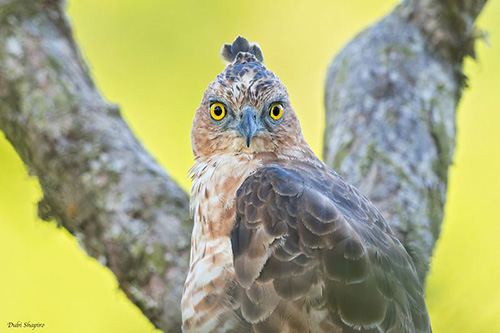
REPRODUCTION OF THIS SPECIES:
The breeding season takes place from December to March, although a nest with a mid-sized chick was found in September in Sabah. The only nest known with a large chick was found in Peninsular Malaysia in February, 35 metres above the ground in the lowest fork of a huge Koompassia excelsa in forest, but another nest was also seen in cleared area.
The nest is made with sticks, and the cup is lined with fresh, leafy branches during the entire nesting period. It is built in tree canopy, in a branch in an emergent tree.
The clutch size is unknown, but only one egg is probably laid.
No more information.
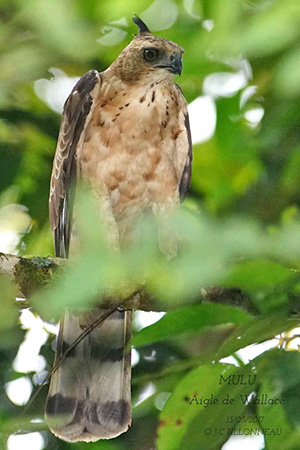
PROTECTION / THREATS / STATUS:
The Wallace's Hawk-Eagle is heavily threatened by clearing of all lowland forests, especially in Thailand.
The global numbers have declined caused by habitat destruction, degradation and fragmentation for commercial logging and conversion into palm oil plantations and agricultural land. Forest fires are increasing and severe.
However, the species is able to adapt to some degree of habitat change, and it can be seen across oil palm plantations in Sabah.
The size of the population is roughly estimated at 3,500/15,000 individuals.
The species occurs in numerous protected areas such as National Parks and Wildlife Reserves throughout the range.
The Wallace's Hawk-Eagle is currently listed as Vulnerable.
